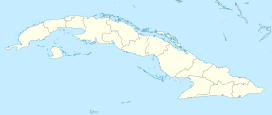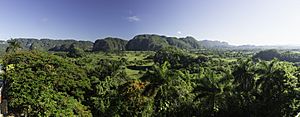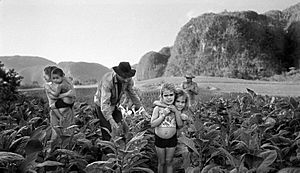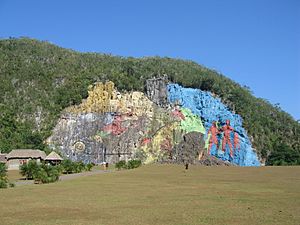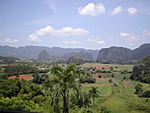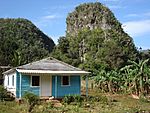Viñales Valley facts for kids
Quick facts for kids Viñales Valley |
|
|---|---|
| Valle de Viñales | |
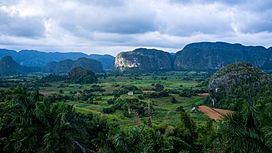
View of the Viñales Valley
|
|
| Area | 132 km2 (51 sq mi) |
| Geography | |
| Type: | Cultural |
| Criteria: | iv |
| Designated: | 1999 (23rd session) |
| Reference #: | 840rev |
| Region: | Latin America and the Caribbean |
The Viñales Valley (which is Valle de Viñales in Spanish) is a special valley in Cuba. It's known for its unique landscape, called a karstic depression. This means the land has been shaped by water dissolving limestone rock over a very long time.
The valley covers about 132 square kilometers (51 square miles). You can find it in the Sierra de los Órganos mountains, which are part of the Guaniguanico range. It's located just north of the town of Viñales in the Pinar del Río Province. In 1999, UNESCO added the valley to its World Heritage List. It was recognized as a "cultural landscape" because people here still grow tobacco using old, traditional methods.
Contents
What Makes Viñales Valley Special?
Farmers in the valley grow tobacco and other crops. They use traditional agriculture techniques that have been passed down for hundreds of years. People believe these old methods help produce higher-quality tobacco than modern machines.
The valley is full of small farms and villages. People have lived here since the time of the Spanish 'conquistadores' (explorers). Many buildings still show the old colonial-era style. The culture of the valley is a mix of different groups. It includes influences from native peoples, African slaves, and the Spanish colonizers.
Mogotes: Unique Hills
The valley is famous for its strange, rounded hills called mogotes. These limestone mounds rise up like islands from the flat valley floor. They can be as tall as 300 meters (about 984 feet)! You won't find these exact formations anywhere else in Cuba. Similar geological structures are only found in places like the Malay Peninsula, Borneo, Thailand, Laos, Vietnam, and the South China Karst region in Asia.
Caves to Explore
Many caves are hidden in the sides of the mogotes. Some popular ones include Cueva del Indio and Cueva de José Miguel. These caves are fun to explore and offer a glimpse into the valley's natural history.
Fun Activities for Visitors
Viñales is a popular place for tourists. Many people come here for hiking and rock climbing. The climbing scene has grown a lot recently, with new climbing routes being discovered. This has brought more visitors to the area.
Plants and Animals of Viñales Valley
The Viñales Valley is home to many endemic plants and animals. This means they are found only in this specific valley and nowhere else in the world!
Unique Plants
Some of the special plants you can find here include:
- Pachira emarginata (also known as Bombax emarginatum)
- Mountain palm (Gaussia princeps)
- Ekmanianthe actinophylla
- Microcycas calocoma
Amazing Animals
The valley is also a great place for wildlife. Look out for these unique animals:
- Bee hummingbird (Mellisuga helenae), which is the smallest bird in the world!
- Cuban trogon (Priotelus temnurus), Cuba's national bird
- Cuban tody (Todus multicolor)
- Cuban solitaire (Myadestes elisabeth)
- Cuban grassquit (Tiaris canorus)
Mural of Prehistory
In the Dos Hermanas valley, which is part of Viñales, you can see the amazing Mural of Prehistory. This huge painting is on the side of a mogote called Pita. It shows the story of life's evolution in Cuba.
The mural is painted on a very steep rock face. It's 120 meters (about 394 feet) high and 160 meters (about 525 feet) long! The artist, Leovigildo González Morillo, was the Director of Cartography for the Academy of Sciences of Cuba.
The painting shows different stages of life in the Sierra de los Órganos mountains. You can see ancient Guanahatabeyes Indians, huge animals, mammals, and even some mollusks. It's like a giant outdoor history book!
Photo gallery
See also
 In Spanish: Valle de Viñales para niños
In Spanish: Valle de Viñales para niños


